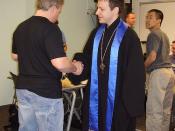Recruitment and Screening of Minors for Group Counseling
Group work emerges as one of the most interesting phenomena in the counseling profession. The sheer number of group counseling methods, which are applied to a wide range of mental health issues for a variety of populations, attests to group work's visibility and impact. Over the last several decades, a surge of research studies have increased knowledge about how certain types of groups are effective under specific conditions (Corey & Corey, 1997). The challenge now is to seek answers to research questions that will help counselors understand how group processes specifically operate in effective groups. The question is not whether groups work, but rather which group-specific independent and dependent variables are associated with successful process and outcome (Corey & Corey, 1997).
BEGINNING COUNSELING GROUPS
A crucial element in starting counseling groups is making decisions beforehand. Pre-group planning is the first step in the process.
Leaders design groups so that they will yield productive and pragmatic results for participants. Among the most important considerations are those associated with objectives, membership, rules, time, place, and dynamics.
OBJECTIVES OF GROUP COUNSELING
Group counseling involves individuals who are having difficulties they wish to resolve that are of a personal, educational, social, or vocational nature (Corey & Corey, 1992). These groups are primarily run in educational institutions or agencies. They deal with specific, non-pathological problems that members are aware of prior to joining and which do not involve major personality changes. For instance, group counseling may focus on how members achieve such goals as relating better to their families, becoming organized, or relaxing in the presence of supervisors at work.
GROUP MEMBERSHIP
Group membership is either homogeneous or heterogeneous. Homogeneous groups are composed of individuals who are similar, such as adolescent boys, single parents or individuals working...


